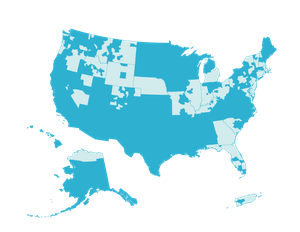Community Development Through a Rural Lens
When I introduce myself to someone and say I work in “community development,” I know most people immediately picture an inner-city neighborhood. Likewise, when I say I work in “rural America,” I know most people picture rolling farmland. But in reality, rural America is made up of hundreds of small towns and large, sparsely populated counties. Community development is just as relevant to those areas as it is to Detroit, Los Angeles or New York City.
Community development anywhere is about community, whether that community consists of twenty dense city blocks, a main street with just one stoplight, or a county made up of several small towns without any stoplights.
Rural communities face many of the same issues that urban communities do. Jobs that pay a livable wage, affordable, quality housing options and access to health care and educational opportunities are often in short supply. And rural families want the same things for their children that everyone does: good health, a safe community, a quality education and a bright future.
Unique challenges for rural development
Rural communities, however, face their own difficulties, such as high concentrations of poverty, poor infrastructure and geographic isolation. What works in urban America doesn’t always translate to solutions for rural America, since the resources and systems to address challenges are not always readily available in rural areas.
Rural poverty affects millions of families, with some areas experiencing continuously high rates of poverty over several decades. Ninety-five percent of counties with the highest rates of child poverty are in rural areas, especially in the Mississippi Delta, Central Appalachia and along the Texas-Mexico border.
Infrastructure and housing stock in rural areas are often poorer than what can be found in cities. There is often simply less housing available in rural areas because the density of units is much lower. Rental housing stock in rural areas is more likely to be older and in poor condition, and more expensive relative to incomes. Homeownership can be difficult to attain, as well, and much of the available housing stock does not meet mortgage criteria. While land costs are low, infrastructure for new construction is expensive and scale is difficult to attain.
The geographic isolation of rural communities is a major hurdle to improving residents’ employment and incomes, since public transit is not available to rural residents. The long distances also make it harder for rural residents to access health care and other critical services. And rural community developers themselves frequently work in isolation. A CDC with a staff of one or two is often the only game in town. Their closest peers may not even be in the same state.
The value of rural community development
At Rural LISC we know that prosperity and opportunity in rural America is good for everyone. Rural areas are the primary source of the nation’s food, water, fuel and recreation and are home to more than 64 million people, 20% of the U.S. population. Rural America is an economic engine for the country; 27.3 million rural adults over age 16 are employed with more than 75% in the private sector.
Rural areas from coast to coast are home to innovative and forward-looking community development initiatives, from small business incubators providing growth engines in small towns like London, Kentucky; to the creation of Energy star-certified homes for thousands of low-income families in California’s Coachella Valley; to the Teche Ridge master-planned neighborhood in New Iberia, Louisiana, which arose from the determination to rebuild “better than before” in the Gulf Coast communities devastated by Hurricanes Katrina and Rita.
Rural community developers have long been role models for how to do more with less. With fewer local financial institutions and foundations, and smaller pools of potential staff members, rural developers have learned to leverage their strong community connections, local government relationships and residents and neighbors to help accomplish their work. Because of their geographic isolation, rural developers make a priority of network building and knowledge sharing across sectors and geographies.
Rural LISC’s approach
Rural LISC believes in rural America, and in the crucial role that nonprofit community developers play in improving the quality of life for rural people. That is why Rural LISC is dedicated to building the capacity of its CDC partners to be stronger and more productive organizations. We support CDCs to think and to work comprehensively, producing healthy housing, arts and cultural projects, job-producing economic developments, health programs and more.
Rural LISC is about connections. We know that in order to prosper and grow their rural communities, community developers in rural America must be connected to the essential resources and expertise they need. Strong and healthy connections result in increased productivity and improved outcomes for rural residents
This year the Rural LISC program celebrates its 20th anniversary. Our annual seminar for our CDC Partners will focus on 20 years of learning what works in rural community development, as well as what is coming for rural development in the future. We will share the key learnings from our seminar with all of you.
In the weeks to come, we will spotlight rural community development here on the LISC Institute for Comprehensive Community Development website. We will feature some innovative solutions and tools from rural communities, highlight some trends in rural development, and present stories of interest to development practitioners from every community.
